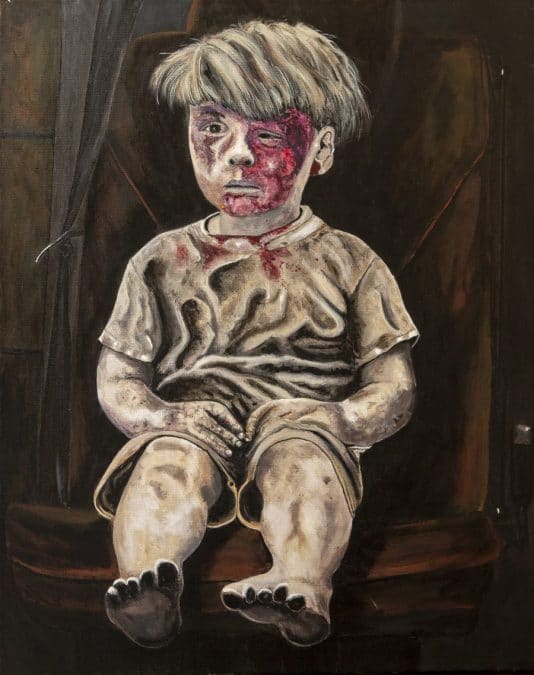Citizen Potawatomi Nation’s Director of Tribal Rolls Charles Clark — Kiktode — recently received recognition for his artistic abilities. The Zoryan Institute, a Canadian-based nonprofit, selected Clark’s painting What is Aleppo for its publication Forces Factors.
Clark’s inspiration for What is Aleppo came while watching a news segment in 2016. A reporter interviewed then Libertarian presidential candidate Gary Johnson, asking him about his thoughts on the bombings of Aleppo, Syria. Although the news reported widely on the conflict, Johnson responded, “What is Aleppo?”

“So, I thought I’d do a painting of Aleppo,” Clark said. “It happened that later on during another news program, they showed people putting a kid in the back of an ambulance, and he was just covered in dust and bleeding. So, I just decided to paint him.”
What is Aleppo showcases Clark’s affinity for creating beautiful art out of the world’s darkness by bringing to light the gravity that issues such as warfare, genocide, politics and more have on cultures and individuals.
The Zoryan Institute chose his painting for its Forces Factors publication as part of its mission to raise awareness of universal human rights, genocide, and diaspora-homeland relations.
“It’s nice to be in on this little bit of recognition. Even though they’re not selling it, that’s awesome to be a part of that. Its’ a good institute,” he said.
Background
By day, Clark heads the Nation’s tribal rolls department, but after work, he passes time painting, mostly around what he calls a “contemporary dystopian” theme.
“The artists that I try to emulate or respect the most are the ones that kind of recorded their history at their time in artwork, and that’s just kind of what I’ve turned out to be,” he said.
While an elementary student at the University School in Norman, Oklahoma, Clark’s talents caught the attention of his art teacher, Ms. Clements.
“She kind of kept a special eye on me because I had a talent that she recognized, but I never did anything with it until recently,” he said.
After grade school, Clark’s interest pulled him away from art. He completed a few projects sporadically over the next few decades, but never really devoted his full attention. In the late 1990s, he began creating regularly before taking another break. Finally, in 2006, Clark set out to hone his craft.
“And I’ve been doing a lot of it since then,” he said.
Style and inspiration
Outside of Ms. Clements’ instruction, Clark has no formal art education. Instead, he relies on personal experience and preference.
“Art, you know, is trial and error,” he said. “You learn as you go along the way. And if you pay attention to what you’re doing, then you know how to make an improvement on the next painting.”
Experimenting with acrylics for What is Aleppo allowed him to utilize a variety of techniques that develop texture and depth.
“It certainly is different because it dries real quickly,” he said. “But what I found is that you can do several layers in a day.”
However, he usually uses oil-based paints.
“There is something about oils that acrylics can’t match,” Clark explained. “Now, I don’t see acrylic as bad, but my preference is oil.”
While some artists favor a quiet room with no intrusions, he works with the TV on and his 13-year-old cat, Hank the Tank, as company.
“It’s just part of the environment I create to paint something, and of course, the cat is a constant interruption. But that’s just part of the deal,” he said then laughed.
He enjoys using large canvases, letting his hands and fingers blend colors and create shapes.
“I’ve learned to do the background first,” he said. “My biggest early mistakes was painting the tree first then going back to do the background.”
To help creativity flow organically, Clark works without the added pressure of deadlines and extreme expectations.
“I’ve just learned over the years that a painting gets done when it gets done,” he said. “And it doesn’t matter how much time it takes.”
Clark has completed more than 200 original pieces of art to date. While the Zoran Institute’s publication Forces Factors is not available to purchase, find artwork examples and more information about Clark at kiktode.com.
